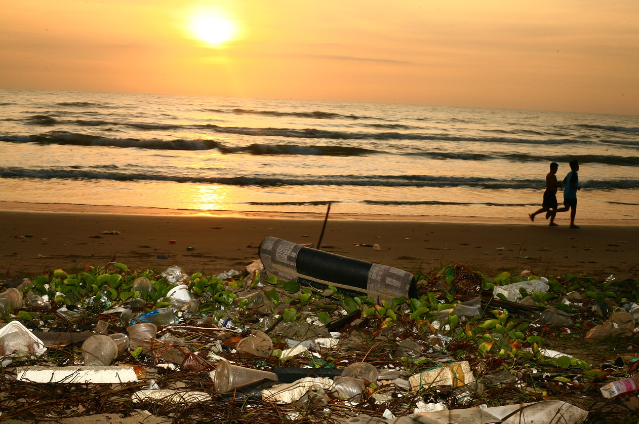
What is Ocean Pollution?
Every year, 8-10 million metric tons of plastic waste end up in the world’s oceans, choking marine life and disrupting ecosystems. Ocean pollution refers to the introduction of harmful substances like plastics, chemicals, oil, and waste into the oceans. The majority of pollutants make their way to the oceans due to human activities, which have turned them into dumping grounds, with wastewater runoffs being the biggest contributors to polluting the oceans.
From marine organisms to humans, polluting the oceans has severe consequences on the entire ecosystem. Besides poisoning and hurting aquatic animals, ocean pollution doesn’t just stay in the oceans; it enters the food chain and affects the seafood we eat through a process called biomagnification, wherein the toxins in the body keep on multiplying as we go higher up the food chain.
In short, ocean pollution threatens the delicate balance between marine and human life. We need to understand its root cause, ripple effects and methods which can help us preserve one of our planet’s most precious assets.
Causes and Impact
Our oceans and waterways are polluted with a wide variety of marine debris, with chemicals and trash being the two main contributors.
Chemical pollution occurs when chemicals from fertilisers used in farms and wastes generated in factories find their way into local water bodies. These wastes get introduced into the oceans due to wastewater runoffs from the water bodies. This increases the concentration of chemicals like nitrogen and phosphorus, leading to algal blooms by a process called eutrophication. Eutrophication is the process in which increased nutrient concentration due to ocean pollution leads to an increase in the growth of algae. As the algae thrive in this water, they reduce the amount of dissolved oxygen in the water, which makes it difficult for other organisms to survive. This leads to the creation of Dead Zones where marine life can no longer survive. Metals such as mercury, lead, arsenic, etc., also get released into the oceans from industries. These metals poison the food chain and lead to biomagnification. One of the best examples of these is the Minamata Disease of 1956, when mercury contamination of the Minamata Bay in Japan led to an epidemic, killing marine animals and the people who ate seafood.
Marine trash includes plastic items like shopping bags, food wrappers, beverage bottles and also cigarette butts, fishing nets, fishing rods, abandoned boats, etc. On one hand, fish get tangled in the wires of the nets that get tied around their bodies. Such nets are also termed ‘ghost nets’ as they make the marine animals, especially turtles, drown while they desperately try to free themselves. On the other hand, they feed on tiny bits of broken-down plastic, called microplastic. These plastics are less than 5 mm in diameter and have been detected inside many organisms, from phytoplankton to whales. Besides spreading illness among the aquatic animals, these microplastics also find their way up the food chain. Over 1 lakh marine animals and 10 lakh seabirds die every year due to plastic ingestion.
Ocean pollution has also led to the formation of garbage patches around the world. Garbage Patches are areas in the ocean where all the trash gets accumulated due to the ocean and air currents. These patches appear like islands made of plastic and trash, and, as the National Oceanic and Atmospheric Administration says, more like flecks of microplastic pepper swirling around an ocean soup. The Pacific Garbage Patch is one example of such a collection, with plastics and microplastics floating on and below the surface of ocean currents between California and Hawaii in an area of about 1.6 million square kilometres (617,763 square miles), with its area set to increase as we dispose of more wastes in the ocean. It is one of five such large garbage patches that have been discovered across the globe. Also called ‘gyres’, there are two gyres in the Atlantic Ocean, two in the Pacific and one in the Indian Ocean.
Solution And What’s in Store For The Future
Preventing wastes from reaching not only the oceans, but any water body is the only solution we have besides cleaning what is already there. Governments, innovators, and citizens should and are stepping up to protect our oceans and reverse the damage we have done.
- The United Nations passed the Global Plastics Treaty, aiming to curb plastic production.
- The Ocean Cleanup is an NGO dedicated to removing plastic waste from the oceans and rivers, aiming to eliminate 90% of ocean plastic by 2040.
- In India, NGOs like Drishti Foundation Trust organise large-scale beach cleanups and community education programs to spread awareness about ocean pollution.
- Biodegradable plastics are being put into use, which can dissolve in seawater, preventing microplastic formation.
- Artificial Intelligence is being used to remove waste in smaller water bodies, ensuring they don’t reach the oceans.
- Revive Our Ocean is a community initiative that educates coastal people on managing marine areas.
- In India, Voluntary Marine Conservation Areas (VMCAs) allow locals to designate no-fishing zones and promote eco-tourism and marine research.
Conclusion
The ocean is not just a vast expanse of water; it’s the reason for life on Earth. It regulates climate, sustains biodiversity and feeds millions. Yet, given our history of negligence, we have turned them into dumping grounds. We watched as fish suffocated, turtles tangled, and seabirds mistook bottle caps for food. And what did we do? We invented more plastic. We poured more chemicals. We called it "progress." But there is hope. Governments are cooperating, innovations are surfacing, and communities are rising. Whether by supporting sustainable choices, participating in cleanups, or simply educating those around us, every effort counts.
